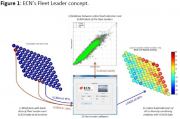
◀ Back to projects overview P201102-002-ECN
Flight Leader concept for cost-efficient load monitoring and O&M optimisation
Project description
Main results and recommendations:
- The ECN Fleet Leader system applies the concept of a few turbines in an offshore wind farm that are equipped with mechanical load measurements. Using relations between load indicators and standard SCADA parameters the load history of all turbines in the wind farm can be assessed and decisions on O&M in the offshore wind farm may be improved significantly because the operator understands the operational status of its wind turbines.
- Implementation of Fleet Leader leads to a theoretical cost reduction of 9.05% on the costs of O&M. Using the FLOW cost model developed by Ecofys the calculated overall expected cost reduction results in approximately a least 1.16%.
- ECN delivered a system to automatically collect the data measured at the Sheringham Shoal wind farm. This allows the Fleet Leader to be operated autonomously.
- The ECN Fleet Leader method has been shown to give an error in the estimated 1Hz damage equivalent load of the flapwise blade bending of less than 5%, and of tower bending of less than 8%. This shows the success of the method.
Project description
The (current) high O&M costs can be partly attributed to the fact that current maintenance practices are highly reactive in nature: when a turbine fails the turbine is repaired. ECN developed a new and promising method to assess the load history of all wind turbines in the wind farm with the aim to optimize the maintenance strategy based on the condition or remaining lifetime of the turbines and their mechanical components. The ECN Fleet Leader concept is illustrated in Figure 1.
In the ECN Fleet Leader concept a few turbines in an offshore wind farm are equipped with mechanical load measurements. Using relations between load indicators and standard SCADA parameters (e.g. wind speed, yaw direction, pitch angle, etc.), decisions on O&M in the offshore wind farm may be improved because these are based on significantly more knowledge of the load history of all the wind turbines.
A demo version was completed in 2009 and was verified by few measurements and experiments in both an onshore and offshore wind farm (proof-of-principle). Statoil has acknowledged the potential benefits of the Fleet Leader concept and did set up mechanical load measurements on two turbines in the Sheringham Shoal wind farm as part of the current FLOW project. At the end of the project the developed Fleet Leader software and associated knowledge and working procedures are ready and available for commercial implementation in offshore wind farms. In order to meet the project objectives the following work packages have been defined:
- Measurement infrastructure: Statoil will set up a suitable measurement campaign in the Sheringham Shoal wind farm, which will enable proof-of-feasibility of the Fleet Leader concept.
- Development of knowledge for O&M optimisation: It is essential that critical loads for the degradation of the main wind turbine components are identified and monitored.
- Fleet Leader software: The Fleet Leader software needs to be further developed into a commercial version, which can be operated by a wind farm operator autonomously, without assistance from ECN to monitor and analyse the load accumulation of all turbines in an offshore wind farm.
- Endurance test: Using the developed software and new knowledge on the critical load indicators, the Fleet Leader output will be used to optimise O&M in the Sheringham Shoal wind farm and to assess the economic benefits of such an approach.
Project results
A small summary of the main project results is displayed below:
- Two Fleet Leader turbines in the Sheringham Shoal wind farm are instrumentation by Siemens in order of Statoil. Loads data and Fastlog data are being transferred automatically from Siemens to ECN and processed using the Wind Data Management System.
- The critical loads are identified for different components inside a wind turbine using load measurements on a few key locations allowing to determine remaining life time of components. In the current project only global loads of the blades and the tower have been applied as load indicators, i.e. blade root bending moments tower bottom bending moments which can be measured straightforwardly. When more specific load indicators for certain components have to be determined, probably more sophisticated load measurements are required, where use can be made of the procedures developed within the EU funded project Protest (http://www.protest-fp7.eu/publications/), which give guidelines of transferring global loads which can be measured to local component loads.
- The actual correlation between load and fatigue has been determined, unfortunately so far a clear correlation could not be observed yet, likely because Sheringham Shoal is a relatively young windfarm
- In order to develop the software into a commercial version a number of improvements have been applied based on the feedback of the end user and based on the experience obtained by applying the concept for the Sheringham Shoal wind farm.
- Processing the measured data provided by Siemens required the addition of special features to the graphical user interface, enabling the user to carry out plausibility checks on the imported data.
- Using rotor speed, pitch angle and power output as ‘predictors’ was a good set of parameters. The prediction accuracy is in the order of 5% to 8 % for the damage equivalent flap wise blade bending moment and damage equivalent tower bending moment respectively.
Contribution to cost and risk reduction of far-offshore wind energy
Using the FLOW cost model, the project deliverables contribute to cost reduction of 9.05% on the costs of O&M for offshore wind farms. The calculated expected cost reduction associated with this results in approximately 1.16% cost reduction.
Presentation
![]() Windkracht 14: Health monitoring
Windkracht 14: Health monitoring
Partners involved
- ECN
- Eneco
- TenneT
- XEMC-Darwind
Contact details
Mr. Toine Curvers
Project documents
Presentation


 Share this page
Share this page
